Last Chance to Catch NYC's Holiday Notalgia Train
We met the voices of the NYC subway on our nostalgia ride this weekend!


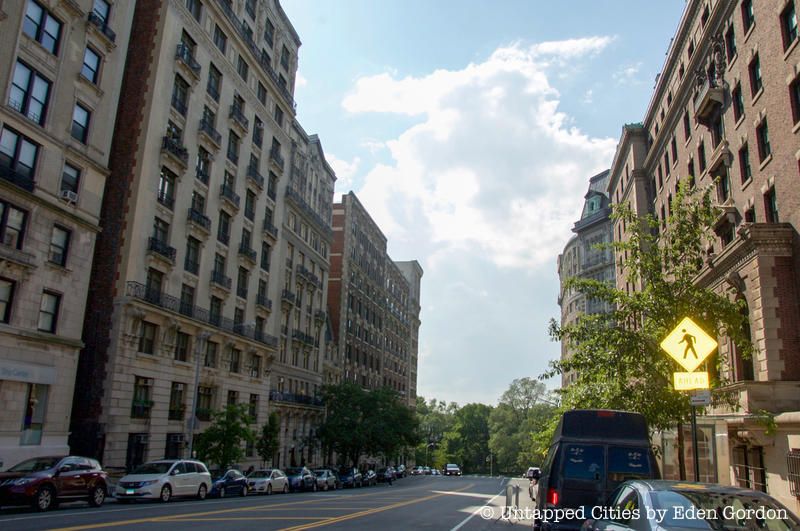
Morningside Heights, the area between 110th and 125th street on Manhattan’s Upper West Side, is home to many famous landmarks including Columbia University and Riverside Park, next to the Hudson River. In its early days, Morningside was known as Vanderwater Heights, named after its original 17th century landowner. In the 1890s, its name was changed to “Morningside” because of its location by the Hudson, which made it a prime location for watching the sunrise. Eventually, the neighborhood became a home for the upper middle class, but grew less desirable in the latter half of the 20th century.
Today, Morningside Heights is a racially and ethnically diverse neighborhood that is home to a wide variety of groups – though charges of gentrification abound. Still, the area is full of surprises and history—once you know where to look. This relatively quiet uptown spot has many hidden gems, including peacock-inhabited gardens, cozy cafes, and remnants of the insane asylum that used to call it home.
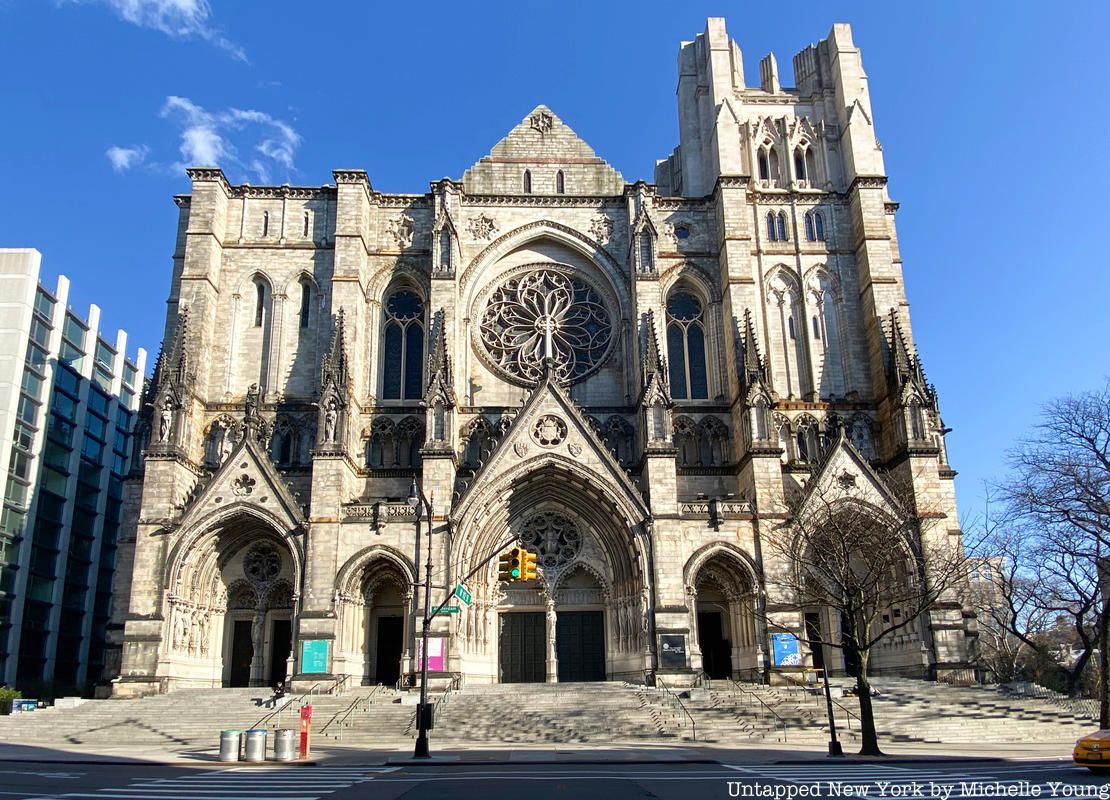
The Cathedral of St. John the Divine is an imposing force that commands instant attention, and so it is a natural place to begin your tour of Morningside Heights. The cathedral was officially chartered in 1878, but did not come close to being finished until 1925, when cathedral trustee Franklin D. Roosevelt chaired a fundraising drive to complete the building. Its construction continued through 1941, when the bombing of Pearl Harbor halted the process. For 32 years, nothing was added to the cathedral, which lay unfinished. Since then, some restoration work has been done, but the cathedral was never actually finished.
The cathedral offers several tours, including the behind-the-scenes “Vertical Tour,” during which visitors climb 124 feet up hidden spiral staircases and over buttresses while learning about the cathedral’s architecture, stained glass windows, and storied history. The tour culminates in a beautiful view of Manhattan, seen from a perch usually reserved for the birds on Gothic cathedral’s roof.
In addition, the cathedral’s Biblical gardens are home to three peacocks, one white and two blue, all of which walk freely around the grounds.
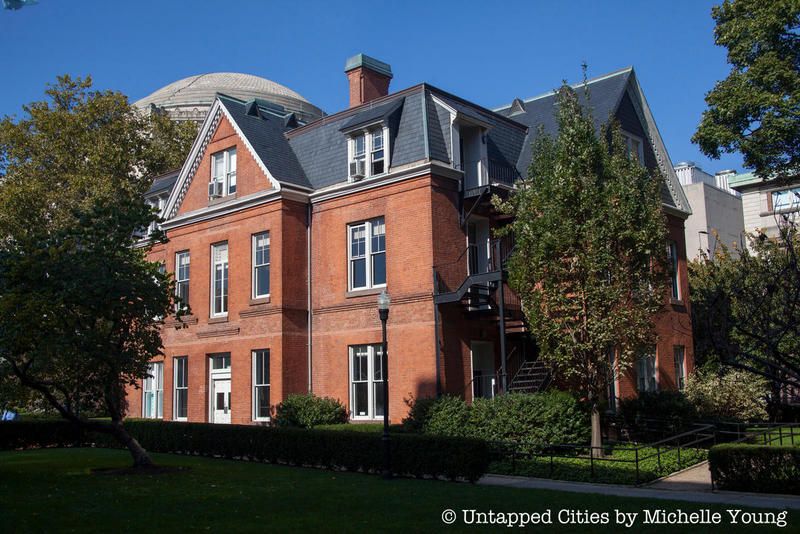
Before there was Columbia University, there was the Bloomingdale Insane Asylum. This home for the mentally ill dates back to when New York was New Amsterdam, governed by the Dutch. The asylum was chartered in 1771 and was completed by 1821, and began accepting patients that year. Starting in 1841, poorer patients were moved to the New York City Lunatic Asylum, located on what is now Roosevelt Island, so the majority of Bloomingdale residents were from upper-class families.
In 1872, the journalist Julius Chambers conducted an undercover investigation into the asylum, staying there for ten days. Afterwards, he published a series of articles in The New York Times that exposed various abuses suffered by inmates, and this led to major staff changes and ultimately spelled the asylum’s downfall.
In 1892, the asylum sold its land to Columbia University. Only one building still remains, acting as a spectral memory of a past that has otherwise been long buried. Buell Hall is an unimposing reddish-colored building that now houses the Maison Française, Columbia’s French cultural center and classrooms for the Graduate School of Architecture, Planning and Preservation, which runs the Arthur Ross Architecture Gallery, and the Buell Center.
Almost unnoticeable between St. Paul’s Chapel and the gigantic Low Library, it begins to look more and anachronistic the longer you stare at it. Originally called the Macy Villa, it was supposed to be a place where the facility’s wealthiest male patients could live in relative comfort. It somehow managed to evade the many major renovations completed by the college, and has remained virtually unchanged to this day, though it was moved literally across the campus.
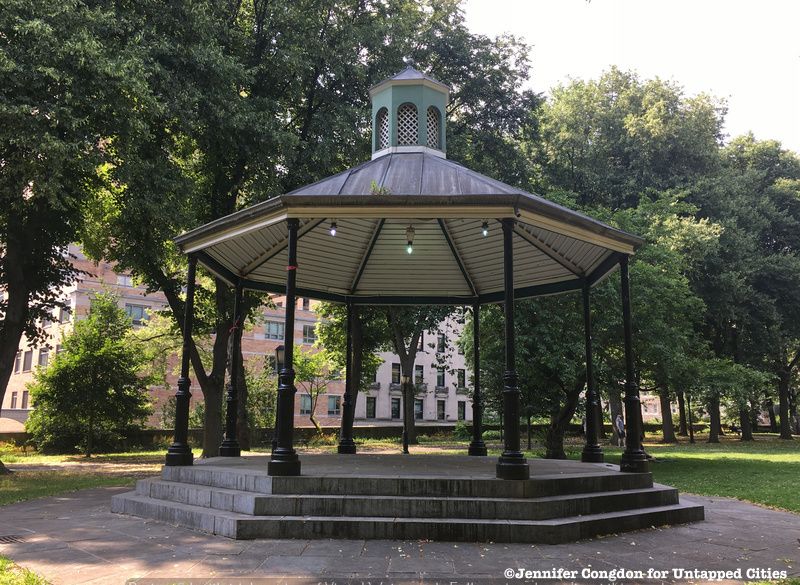
Just north of Riverside Church, there is a relatively inconspicuous flight of stairs that leads to Sakura Park. An idyllic stretch of green and brown, Sakura Park is an offshoot of Riverside Park, and it is located in between Claremont and Riverside Drive. It takes its name from the 2,500 cherry trees that New York City received from Japan in 1912 as a gift from the Committee of Japanese Residents of New York. The original shipment of the trees, sent out in 1909, was lost at sea, but four years later the trees finally arrived and were planted in Riverside and Sakura Park.
The park’s landscaping was financed by John D. Rockefeller, who owned the land in the 1930s and commissioned Frederick Law Olmstead, Jr. to turn the park into the elegant space that it remains today.
The park has several statues, including one of General Daniel Adams Butterfield, which was specifically designed to face Grant’s Tomb. Butterfield was the Assistant Treasurer of the United States during Grant’s presidency and the Civil War.
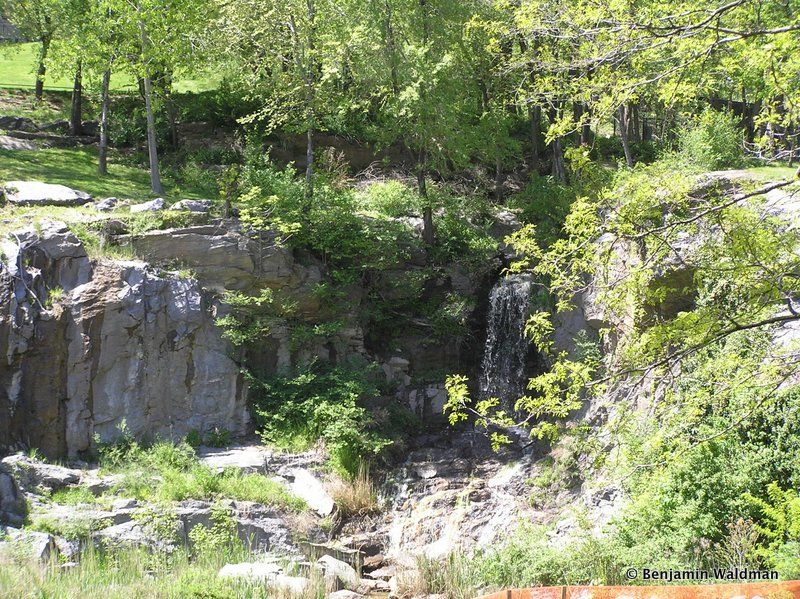
Towards the East Side is Morningside Park, a stretch of greenery that separates Morningside Heights from the greater Harlem area. The park was proposed in 1867 and completed in 1895. Most of it is located on a cliff of Manhattan schist, the geographic foundation of New York City; the kind found in Morningside Park formed over 30 million years ago. Glacial outcroppings are still visible all over the park, including underneath the foundation of PS 36.
In 1960, Columbia University attempted to build a gym in Morningside Park, and planned to install separate east and west entrances that would effectively separate the university from Harlem. After occupying the park and classrooms and shutting down the university for several weeks, activist groups successfully stopped construction. In 1981, a group of students founded Friends of Morningside Park, and since then have worked towards its rehabilitation.

Barnard College’s newest completed building is the Diana Center, which opened in 2010. It was designed by Marion Weiss and Michael A. Manfredi to be a center for social, academic, and cultural life at the college. Barnard is Columbia University’s all-female counterpart, and its small campus is tucked away across the street from Columbia’s, but with its glass windows and bold red-orange paint job, the Diana is a statement piece all in its own.
The Center has eight floors and includes a 500-seat multipurpose event space, a 100-seat black box theater, two cafes, art rooms, an open-air green rooftop garden, and more. It contrasts the rest of the campus’s terra-cotta with its sleek energy-efficient curtain of panels and glass. The building was conceived as an inverted campus quad, and features translucent fritted glass that allows an interchange of energy and light to flow between the outside and inside worlds. Named after donor Diana Vagelos as well as the Roman goddess, huntress, and feminist icon Diana, it is a focal point of Barnard’s campus. Soon enough, The Cheryl and Philip Milstein Teaching and Learning Center, which is currently under construction, will rise up and replace Diana as Barnard’s most modern building.
Right across from the Diana Center is the Columbia University Northwest Corner building, built in 2009, which resembles the Diana with its multitude of windows and glass walls. It houses twenty-one science labs on seven research floors, as well as a cafe and the university’s gymnasium, and was designed by Rafael Moneo Valles of Madrid, Spain. Colloquially called NoCo, the building features sustainable and low-vibration design and boasts fantastic views of New York City from the labs on the top floors.
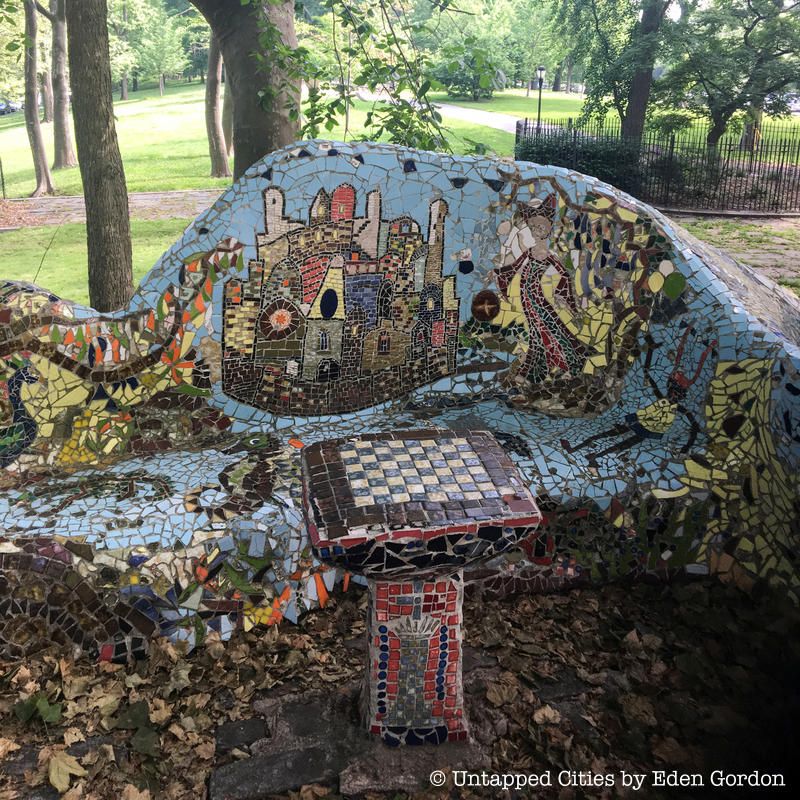 One of Pedro Silva’s mosaic benches
One of Pedro Silva’s mosaic benches
Riverside Park is home to a great many beautiful things, including an imposing building that seems to rise straight out of the ground. The stony Grant’s Tomb, designed by John Duncan and finished in 1892, houses the bodies of President Ulysses S. Grant and his wife Julia.
The tomb’s stoic grey color scheme is broken up by a collection of folk art set up around the monument. In the 1970s, an installation of concrete benches decorated with colorful mosaics began to be constructed around the tomb. During a three-year period, seventeen benches were built by the artist Pedro Silva with the help of hundreds of local children. The installation, entitled “The Rolling Bench,” sparked some controversy when critiques accused it of disrupting the tomb’s severity, but adds a great deal of character and color to this picturesque location.

The Cathedral of St. John the Divine is home to a priceless twelve-panel series, created in Rome between 1644 and 1656, called the Barberini Life of Christ tapestries. They were designed by Giovanni Francesco Romanelli and hand-woven by skilled weavers for Pope Urban VIII’s nephew, Francesco Barberini. The series previously hung in the Vatican and in Barberini family palaces before making the trip to America in the late nineteenth century.
The massive, fifteen-foot-tall panels reveal a window into the brilliant hues and fantastic imagery that colored the imaginations of Roman artists. They had been hanging in the cathedral’s main sanctuary for years until an unfortunate fire destroyed two of them and damaged the rest in 2001. Restoration efforts have been continuous since then, and the tapestries’ installation has marked a triumphant return. They will be view through July 16, 2017, from 8am to 5pm daily.
Read more about the Barberini Life of Christ tapestries here.
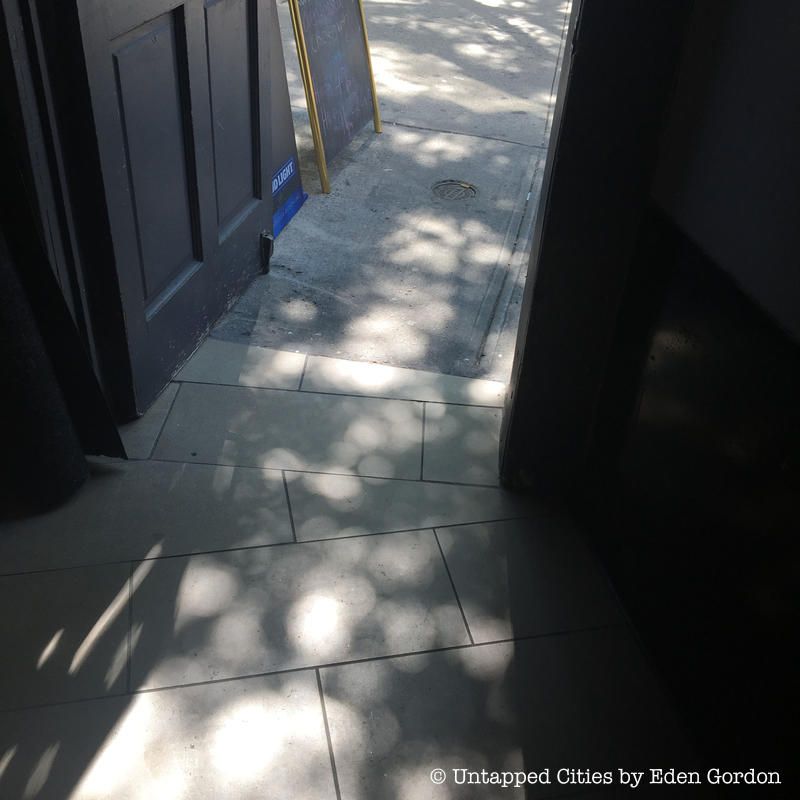
Another relic from Morningside’s asylum days is a road colloquially called Asylum Lane — built by original Dutch owner Harmon Vandewater — that cut diagonally across the city. The road stretched roughly from today’s West 111th street, up through West 113rd.
A closer look reveals that the road still influences Morningside’s architecture. For example, as shown in the picture above, the doorway to the Heights Bar and Grill at 111th street is slanted, pointing towards the place where the road would have cut through it. Several other buildings have walls built at angles because of the old street.
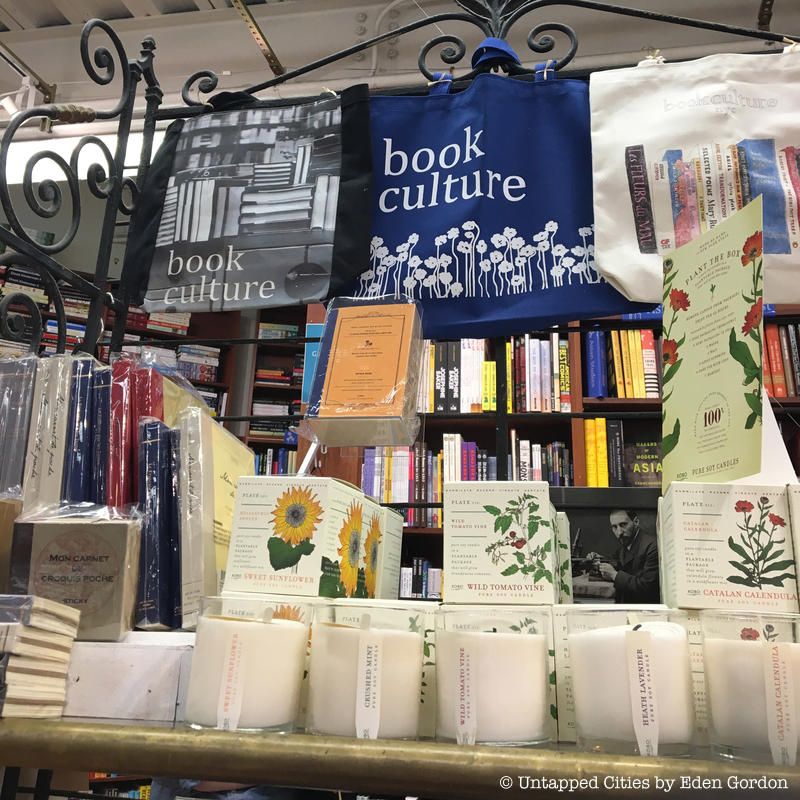
In keeping with its reputation as an “Academic Acropolis,” due to its position on top of a sloping hill and its large quantity of academic institutions, Morningside Heights is home to the well-stocked Book Culture. The store has two locations—one on 114th street and Broadway, and another on 112th street, between Broadway and Amsterdam.
The store is full of books, literature-related gifts, and office supplies. It also carries a wide variety of cutting-edge arts and culture publications. In its 112th location, there is a second floor that supplies many students with their course books—so there is a vast treasure trove of volumes on almost any topic. Though pricey, the store’s design is aesthetically pleasing, and it always has beautiful additions of new and old books available for browsing and purchase.
Book Culture was founded in 1997 by Labyrinth Books, back when Morningside Heights became a ghost town in the summers and was frequently a gathering place for biker gangs. Since then, it has gone independent, changed its name, and moved into a Columbia-owned space, becoming the literary haven it is today.

This cafe, located on 122nd and Amsterdam, rivals the aforementioned Hungarian Pastry Shop in charm and mystique. Max Caffe serves heavier fare than Hungarian — you can order lunch or dinner there — and it boasts many comfortable couches and is meticulously decorated in a vintage Italian style.
The dim lighting and romantic ambiance makes this a perfect place to take a date for a glass of wine, or to read a good book while drinking a latte. Free wifi is available. Plus, the music selection is usually good — a selection of classic jazz and nostalgic songs are always in rotation. When it’s sunny or warm, you can sit at one of the tables outside. It is the perfect place to end a long day after wandering around Morningside Heights, and it is open until 11:30PM each night.
Although it was in 2001, the cafe feels much older. It has many wooden doors that appear to lead to nowhere, and they give the impression that the cafe is hiding something underneath it — perhaps an opium den or a dungeon.
Its website reads,”embracing the delightful aroma of coffee and friendly atmosphere, the constant stream of locals meet at Max Caffe for a chat and a cup and magically they are transported to bygone times, when patrons would cluster around and make one cup of coffee last for hours.” Indeed, the cafe feels timeless and timeworn at the same time, caught in the past but always creating a reason to embrace the present.
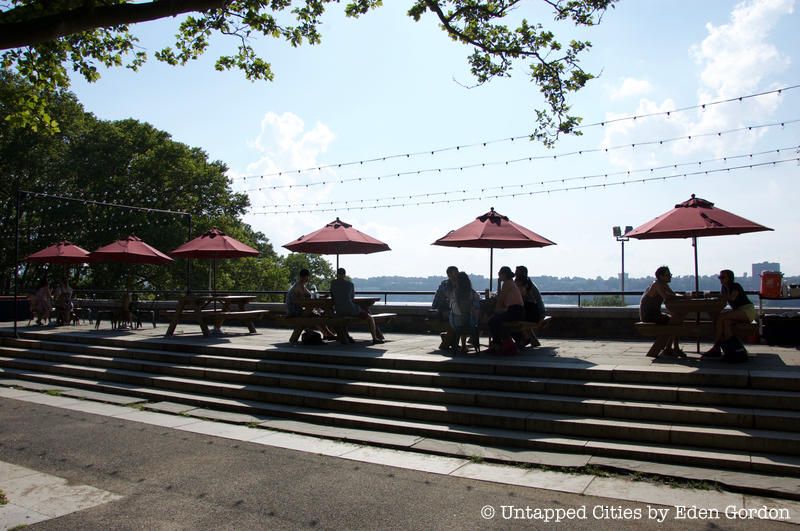
Though its 105th street location puts this semi-hidden restaurant on the outer edges of Morningside Heights, this charming locale provides an opportunity to dine in style while watching the sun set over the Hudson. Located on Riverside Drive next to the West Side Highway, Ellington in the Park’s minimalist decor creates a feeling of vivacity and cheer, and it is a common destination for locals to come together for family dinners or Sunday brunches. The seasonal spot offers a varied fare of salads, quesadillas, burgers, and more, and was named the “best place to have a beer on the Upper West Side.” You can also book the restaurant for private events for parties of 25 or more.
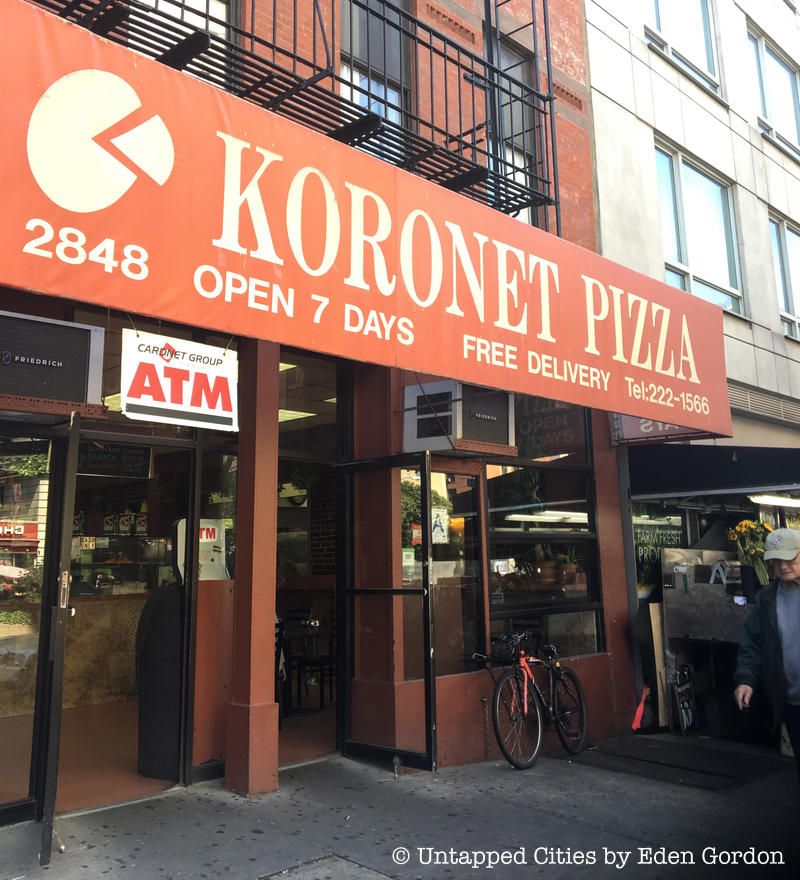
If you’re feeling up to a challenge, order a slice of pizza at Koronet. Famous for their gigantic size, these slices are so huge that nothing can adequately prepare the average pizza consumer for the enormousness of a single one. Slices cost $2.75.
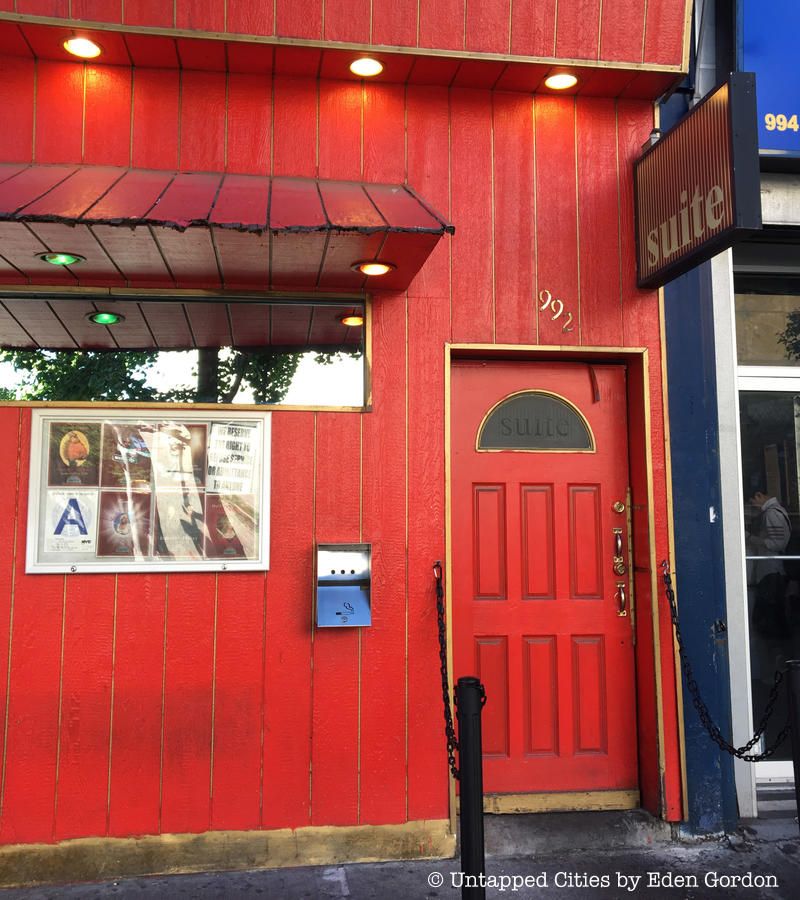
Lastly, if you’re looking to do some local late-night carousing, look no further than Morningside’s collection of bars and clubs. Though nothing like the downtown scene, there’s a homey charm to many of the uptown destinations. One bar to check out is Suite, a gay bar that hosts nightly drag queen shows that begin at midnight each night.
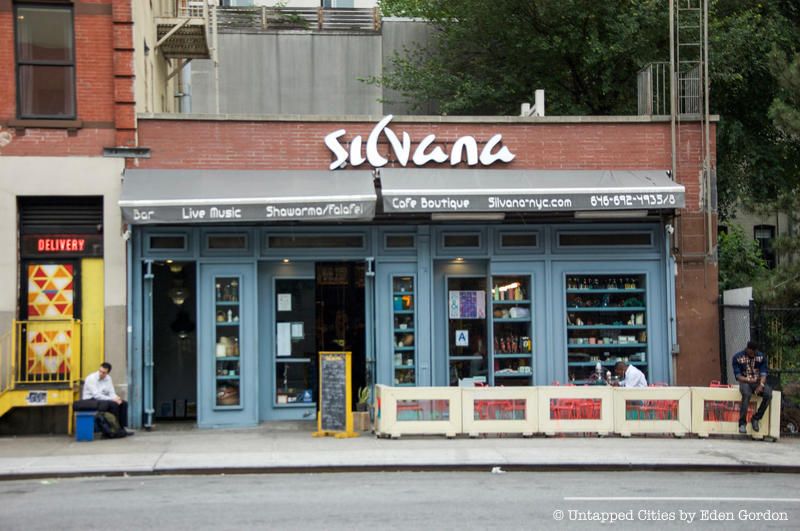
Technically in Harlem, Silvana is a very short walk from Morningside Heights, and it is well worth the trip. The cafe serves Middle Eastern fare on its upper level, and its lower level serves drinks and functions as a hookah bar. It also offers extensive live music programs that run late into the night, featuring anything from jazz to reggae to psychedelic rock. Open for coffee at 8am, Silvana remains open till 4am, making it an equally great place to start the day or end the night.
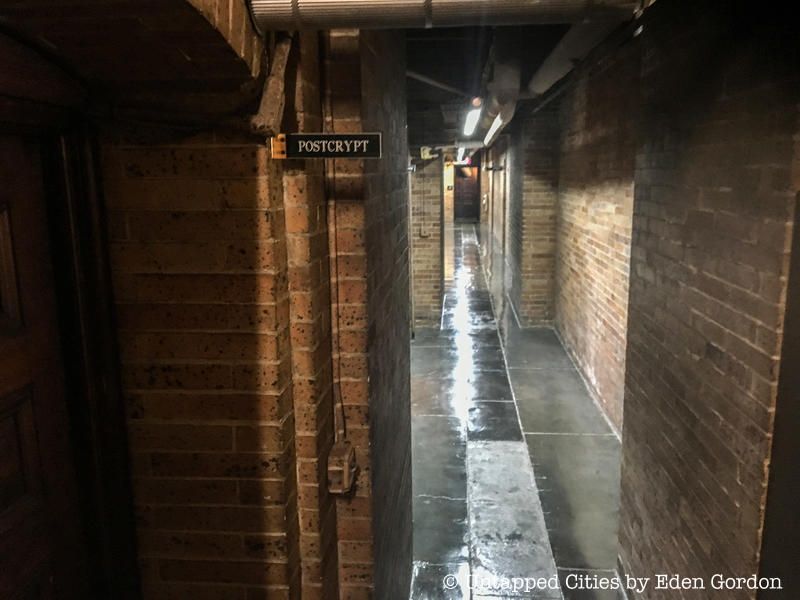 The entrance to Postcrypt Coffeehouse, in the basement of St. Paul’s Church
The entrance to Postcrypt Coffeehouse, in the basement of St. Paul’s Church
St. Paul’s Chapel of Columbia University is home to one of Morningside Heights’ most unique places to get your caffeine fix. Hidden away in the chapel’s basement is the Postcrypt Coffeehouse, a music venue that has been “folkin’ around since 1964,” according to its website. It features a variety of up-and-coming folk and acoustic acts. The season has ended for the summer, but come fall, Postcrypt will host acoustic acts every Friday and Saturday as well as a monthly open mic night.
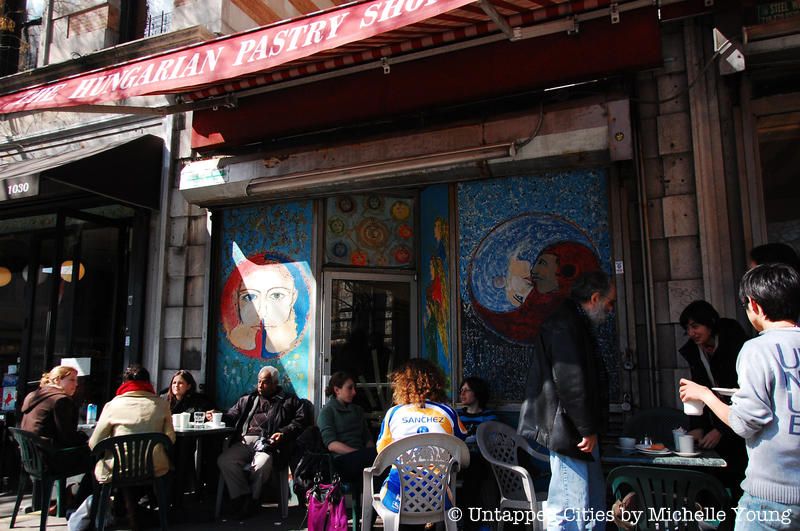
If you’re someone who can’t start (or finish) your day without a cup of coffee, then the Hungarian Pastry Shop is the place to be. Located on 111th street and Amsterdam Avenue, across from the Cathedral of St. John the Divine, this small, dimly lit cafe is a common haunt for university students, locals, and tourists. Since 1951, it has been a favorite location for avid readers and writers, and its walls are plastered with the covers of books that were completed at least in part at one of its small wooden tables.
In addition, its unlimited coffee refills make it a prime destination to buckle down and complete long projects and readings, and its lack of wifi makes the whole place feel like it doesn’t subscribe to a fast-paced idea of time like the rest of the world. Stepping inside feels like slipping into the past, perhaps sailing across the ocean to a movie-scene version of Europe. The abstract art on the walls—mostly blurred faces drawn in black ink—is strangely compelling, and the stained-glass windows and hand-painted menus give the place a homey feeling.
One of the best parts of the Hungarian Pastry Shop is its bathroom. Repainted in the spring of 2017, the walls have already been covered with drawings, quotes, political statements, and emotional confessions.
For more information, read The Top 10 Secrets of NYC’s Morningside Park and The Top 15 Secrets of Columbia University in NYC.
Subscribe to our newsletter